|
Tsavo West National Park, Kenya July 2000 |
||
| (Click any photo throughout to see a larger version) | ||
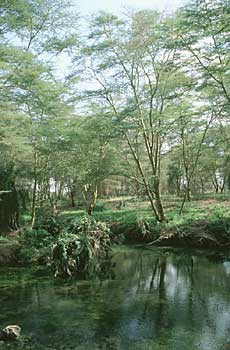
|
||
| Scenery at Finch Hatton's | ||
|
Our first stop on the Kenyan part of our African adventure was at Finch Hatton's tented
camp in Tsavo West National Park. It is a very new camp, so despite the name I'm sure
Isak Dinesen's famous friend never stayed here himself or, if he did, he had somewhat
more primitive accommodations than the beautiful raised wooden decks and marble bathrooms
that our "tents" featured.
Most of Tsavo West is dry, especially during the dry season, and especially during Kenya's current drought. But in the midst of this dry place and time, Finch Hatton's is an oasis of streams and lagoons and yellow acacia trees. These are the trees that were once called "fever trees" by Europeans who associated them with deadly yellow fever, before they figured out that the mosquitos were the real culprits. | ||
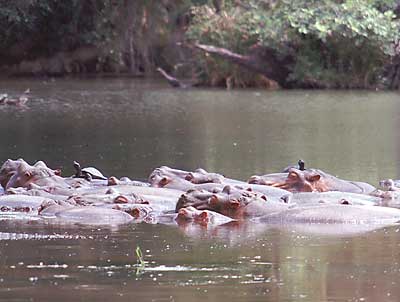
|
||
| Mud Baths | ||
| The local aquatic wildlife, such as these hippos and turtles, were happy to take advantage of this oasis. Our tent was positioned just next to the spot where the hippos exited the water each night to forage, and re-entered early in the morning. We watched the hippo parade with flashlights from our deck. The baby hippos, too young to eat grass, would stay behind in the pond. Much splashing occurred on both exit and return. | ||
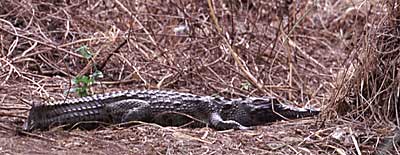
|
||
| A Nearby Napper | ||
| In addition to the hippos and turtles, the lagoons were occupied by Nile crocodiles (Crocodilus niloticus). At night we would see them by flashlight drifting in the water, but during the day they mostly napped. This was a little guy, maybe three feet long including the tail, hanging out on the banks of the lagoon 10 feet or so from our tent. | ||
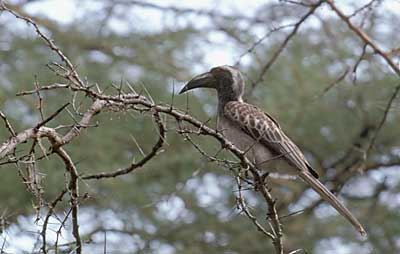
|
||
| African Grey Hornbill | ||
| Plenty of birds hung out around Finch Hatton's also, including this African grey hornbill (Tockus nasutus). We loved the interesting and beautiful hornbills, and were happy to discover that several species were quite common. | ||

|
||
| Hippo Pile | ||
| Speaking of common, there was certainly no shortage of hippos anywhere the stream was sufficiently wide. This pile o' hippos were conveniently situated near the vehicle track, so we got a great close-up view. | ||
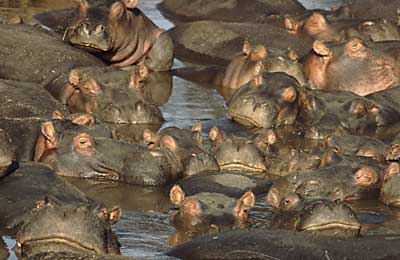
|
||
| Mud, Wonderful Mud | ||
| Here's a portion of that same hippo pile from a different angle with different light. Such charming animals, so very cute. Shortly after admiring this collection, our Kenyan guide Albanus told us of a tourist who came out of his tent to videotape a hippo and ended up with a hippo-bite-sized portion of his rear end removed. But see how peaceful and sweet they look? | ||
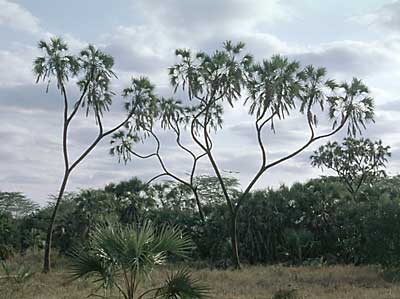
|
||
| Doum Palms | ||
|
Albanus told us that doum palms like these were the only palm
trees with branches. "Ah", we thought, "no wonder they look so
strange." 100 points to the first person who can identify the
flying bird in this picture. (50 points to the first person who
can even find the flying bird in this picture.)
My friend David Sloo read this and wrote back to point out that this page about palms describes aerial branching as occurring in multiple palm genera, so Albanus's claim was a bit of an exaggeration. Also, I awarded David all of the bird-identification points for "Maybe it's an old-world vulture" (it was in fact a lappet-faced vulture, Torgos tracheliotus, flying off between the two largest palm branches). Nobody else competed, so I deemed it a contestant-takes-all event. | ||
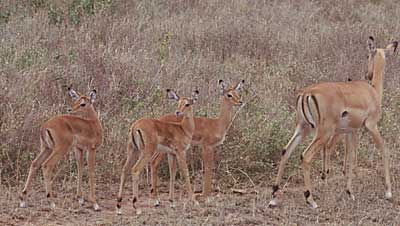
|
||
| Impala Family | ||
| Impala were Kenya's answer to the kob we saw in Uganda. They were everywhere, in huge numbers. And still, this is probably the best picture of impala I came away with -- pretty sad, huh? | ||
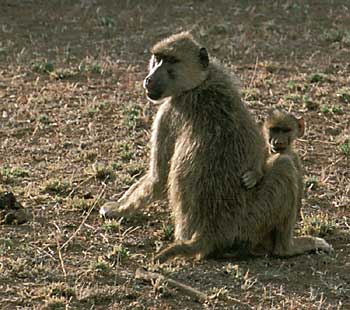
|
||
| Yellow Baboons | ||
| Here's a mother and baby yellow baboon staring at the funny-looking primates in the safari vehicle. We saw a lot of vervet monkeys too, but definitely the most commonly seen primates were baboons. (Yes, even more commonly seen than people, if you only count inside the parks.) Usually they'd be in troops on the ground, from just a few to over 100 individuals. Sometimes some of them would be up in the trees. | ||
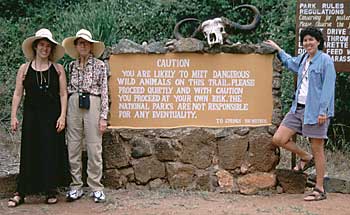
|
||
| The Fine Print | ||
| We always enjoy noticing the difference between wild and dangerous places in America, where fences and rails protect the tourist from all but the most remote chance of real harm, and in other, presumably less litigious countries, where they warn you but don't prevent you from getting into trouble. None of our party were torn to pieces by dangerous wild animals on this trip, you will be happy to know. | ||
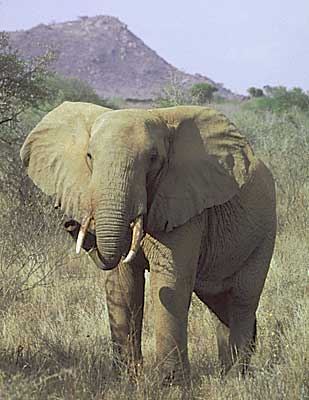
|
||
| Elephant | ||
| Unlike impala, it wasn't too hard to get good pictures of elephants. They mostly ignored the safari vehicles, but some like this one seemed to actually enjoy posing. Probably trying to get onto the cover of National Geographic, the wildlife equivalent of getting on the cover of Rolling Stone. If the elephant had known it was only going to make it onto some amateur photographer's web page, it probably would have come over and gored me. | ||
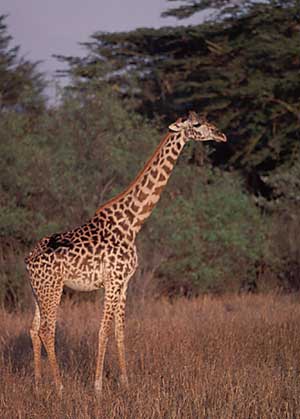
|
||
| Maasai Giraffe | ||
| We saw three types of giraffes in different parks in Kenya. The common or Maasai giraffe pictured here was graceful and beautiful. The other two types were also graceful, and even more beautiful. | ||
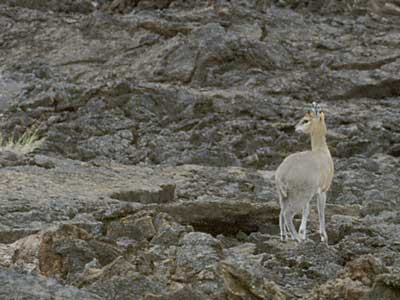
|
||
| Klipspringer | ||
| This was one of the rarer types of antelope we saw in Kenya. Klipspringers are at home on extremely rocky ground, over which they can bound at incredible speed. We saw this one and a companion on the vast Shetan lava fields on the outskirts of Tsavo. | ||
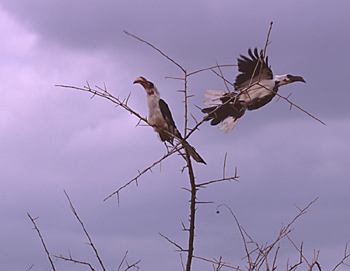
|
||
| Von Der Decken's Hornbills | ||
| Hornbills are most often seen in mating pairs, such as these two Von Der Decken's hornbills (Tockus deckeni), another of the common species. Contrary to popular belief, there is no African equivalent of Froot Loops, so don't even ask. | ||
Onward to Savannah Dust | ||
| Return to Uganda and Kenya Trip Overview | ||